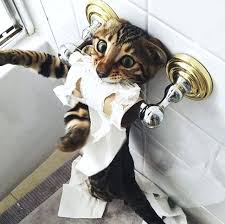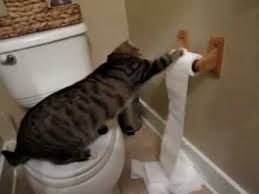Toilet Paper as a Toy?

Does your cat play constantly and contentedly with toilet paper? Does she unroll it sheet by sheet from its cardboard tube, bat it around, drag it from room to room and quite literally “paper” your home in streamers?
If so, any attention you give her for playing with toilet paper as though it were a toy –whether negative or positive – will, in all likelihood encourage her to continue. Why, then does a cat play with toilet paper in the first place? She may be acting on her instinct to hunt, imitating your own actions in the bathroom or simply trying to keep herself occupied. Regardless of her motivation, the solution is both prevention and redirection – shifting her focus away from the toilet paper towards more acceptable, alternative behaviors.
Simply shutting the door when you’re not around makes the bathroom(s) off-limits to your cat. A toilet paper holder that completely covers the roll can be a useful alternative if it’s difficult to keep the  bathroom door(s) closed all the time.
bathroom door(s) closed all the time.
Provide more creative outlets for your cat’s energy and reward her when she chooses them. Because of their instinctual desire to hunt, cats enjoy playing with interactive toys that can be “ripped” and “pulled apart” — mimicking the movements they make when killing and devouring their prey in the wild. Food puzzles are an excellent option. There is a wide range of kitty food puzzles designed to provide them with the hunting experience they crave. Movable puzzles whose contents are dislodged or removed by your cat’s paws are particularly effective.
Begin with easy-to-access food puzzles, and as your cat learns how to make them work, increase  the degree of difficulty. To make them even more enticing and exciting, fill them with kibble or treats.
the degree of difficulty. To make them even more enticing and exciting, fill them with kibble or treats.
To encourage her exploratory behavior, hide the food puzzles, some of her most highly prized toys and tiny boxes of cat grass throughout your home, targeting those areas she’s especially fond of such as perches and climbing structures. Rotate them from time to time to keep her “hunts” interesting and to keep her on her paws.
When you’re not at home, keep her entertained – and hopefully away from attacking the toilet paper – by purchasing and using toys with remote-control options, motion-sensor toys, timed toys and/or hanging toys designed for being batted about.
Provided your cat doesn’t EAT paper, consider offering her a designated alternative that she can claw up and bed down in, such as a cardboard box filled with shredded or crumpled up paper or newspaper. And always ensure that a scratching post or two is placed in easily accessible areas.
Whenever your cat plays with the right toys or engages in the appropriate activities, reward and reinforce her paws-itive behavior with treats, petting and praise. If, however, you catch her “red pawed” in the act of toying with the toilet paper, calmly redirect her attention, and clean up the “crime scene” once she’s safely out of sight. Punishing her may not only reinforce this unwanted behavior but cause increased tension in your relationship.
Last but most importantly, if your cat IS eating the toilet paper, speak to your vet or seek help from a certified animal behaviorist.


